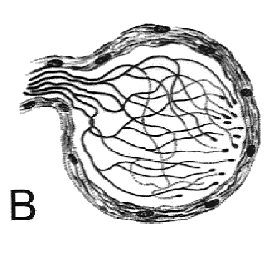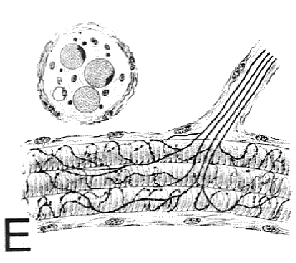VC1.H1.7 and INT.H1.8 Sensory Receptors
Sensory Receptors:
- Sensory receptors are widely distributed in the body
- Sensory receptors vary in structure from simple nerve endings, virtually impossible to detect in histological preparations, to more complex structures
- Complex sensory nerve endings include support cells whose function is to act as transducers to assist in the conversion of a particular sensation, eg light touch, into a signal which can be passed along a sensory neuron
- The accompanying diagram (VC1.Hl.8) illustrates some of the types of complex sensory receptors that can be found in the body
- Appreciate the range of structural formats that they are found in but do not try to commit their structure to memory

Meissner's corpuscle
- Found in skinjust deep to epidermis
- Sensitive to light touch

Krause end bulb
- Found in skin just deep to epidermis but in restricted locations around the body
- Function uncertain

Paccinian corpuscle
- Located deep in the dermis
- Sensitive to vibration / pressure

Free epidermal nerve endings
- Penetrate deep layers of epidermis and have no supporting cells (hence "free")
- Individual endings likely to respond to one type of sensation but this type of receptor believed to include thermoreceptors, nociceptors and mechanoreceptors

Muscle spindle
- Found around skeletal muscle cells and provide information on the state of contraction of the muscle cells
- Help in controlling movement and posture

Ruffini corpuscle
- Found around collagen fibres in tendons
- Respond to stretching of the tendon during muscle contraction
- Help in controlling movement and posture
NB You do not need to learn the detail of these receptors at this stage
